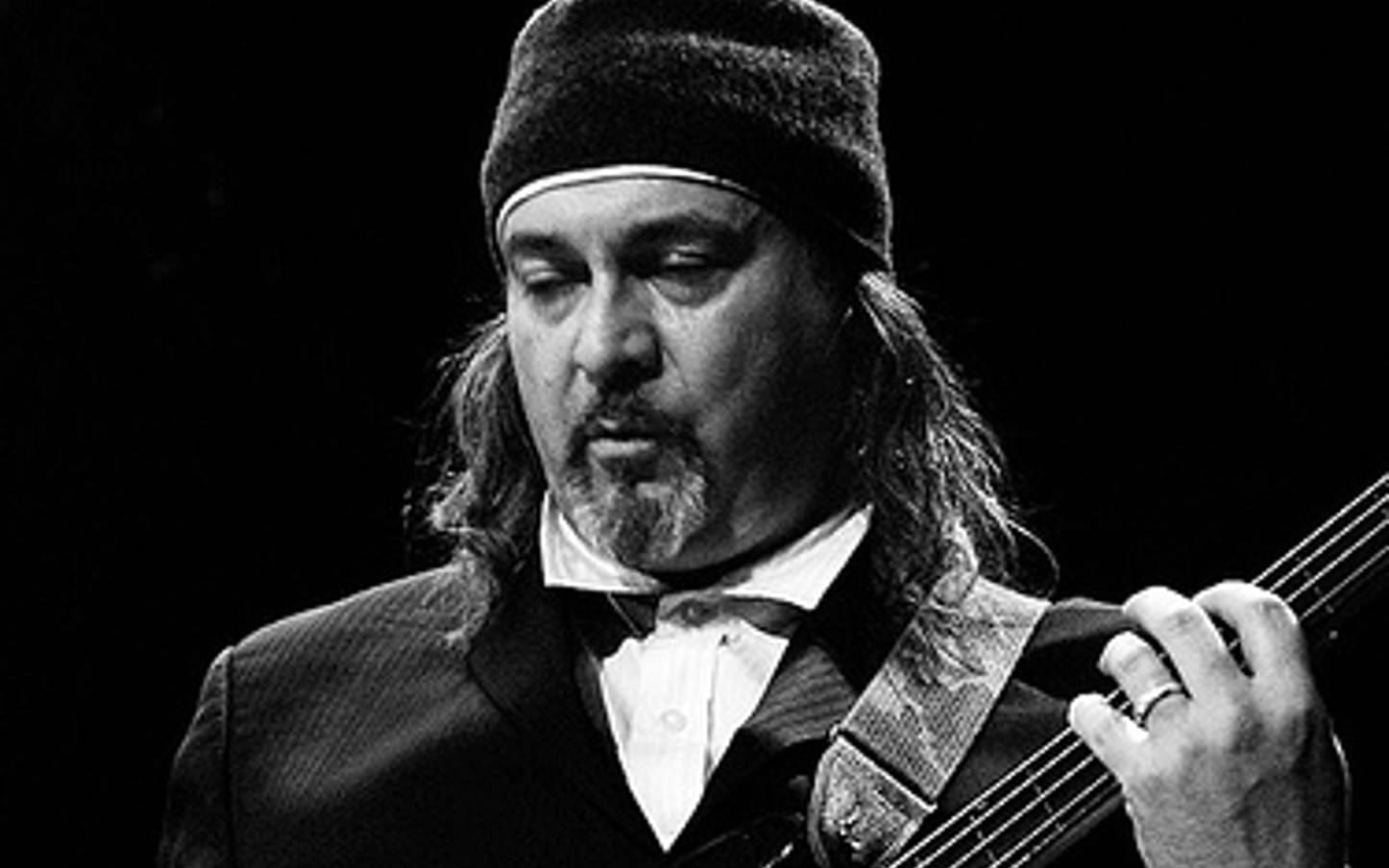Inayat Khan, the Sufi musicologist, believed that underneath all the apparent dissonance among humanity, there was a unity that can be found in God. Of course, that’s what nearly every religious nutso says, but Khan’s take adds music into the mix. Khan was advocating that music could be used as a tool to steer one’s mind into an interior temple of sacred space, a space where we can find “God.” It would seem ironic to suggest that something called “collision music,” could be used as such a musical tool to reach internal vistas of “meta-comprehension” and while providing a short glimpse of the whole divine plan, but Bill Laswell’s collision music does just that. While listening to a Laswell composition you can close your eyes, find the rhythms, and let your mind “travel at magnificent speeds around the universe.” It’s not a quiet journey however, like flying silently through the stratospheres, Laswell’s collision music provides a ferocious container like a futuristic subway train crashing its way through space. Yet, like walking along a busy city street, one can find peace where the sounds of honking horns, construction jack hammers, and a litany of conversations from passerby’s zoom past you like whizzing bullets, one can find peace in that chaos. It’s no wonder Laswell began creating his collision music while living in New York City.
Bill Laswell has been involved in thousands of recordings since he first arrived in NYC in the late 1970s. As both a bassist and producer, he’s created music that runs along a spectrum of everything cool, from jazz, free jazz, grindcore, Hip-Hop, noisy dance music, world music, and spoken word with luminaries like William S. Burroughs, Iggy Pop, and many more. To begin exploring Laswell’s discography, as well as the catalogues of the musicians he’s worked with, one can feel like a pilgrim travelling upon a road to what Burroughs called, “The Western Lands.” As Burroughs said on the Seven Souls album that Laswell produced, “The road to the Western Lands is the most dangerous journey of all.” Laswell’s musical genius has been his ability to compress all the danger involved in seeking to live a life of high spiritual intensity while surrounded by all the insane shit that happens on this planet into his work. Such resonance moves through every sound that he’s produced. NPR once said that Laswell, along with John Zorn, produced “extreme music.” I agree, but would add that Laswell, and Zorn, accurately reflect the extreme times that we all find ourselves living through. Let’s not kid ourselves folks. It’s put up or shut up time for “team human,” and if we don’t connect and work together on a higher level of cooperation, we could all find ourselves breathing our last agonizing breathes on a planet burning like Dante’s ninth circle of hell. In such dark times, we need collision music like Laswell’s to remind us that we can create fresh sounds which reflect our new disjointed communities.
As a solo artist, Laswell has released nineteen albums and counting. As a band member he’s released sixty-five albums through his collaborations with some serious musicians in bands like Material, Massacre, Painkiller, Praxis, Blind Light, The Blood of Heroes, Method of Defiance and more. As a producer, Laswell has worked his sonic wizardry on records from artists like Brian Eno, Herbie Hancock, Motorhead, Public Image Limited, Iggy Pop, William S. Burroughs, Mick Jagger, Anti-Pop Consortium, the Ramones, the Jungle Brothers, Yoko Ono, Sly and Robbie, and Matisyahu, just to name a few. Laswell’s ethereal presence permeates much of the amazingly dope music that emerged from New York City over the last 40 plus years. He has left a labyrinthine map full of many musical roadside attractions. One can sit in concentrated repose and absorb the sounds that he has produced over the years and become transported to the mothership, where the light of musical inspiration raises your consciousness like a UFO tractor beam, pulling you close to that chaotic rhythm of universal creation.
Exploring Laswell’s music has been made exponentially easier with the help of the internet. The journey to listen to nearly everything he’s had a hand in creating has become easier. However, as all mystics know, it is the journey and the search that makes for the most delectable discoveries. Growing up just outside of New York City, as a teenager walking through Greenwich Village, where posters, stickers, and papers are plastered on light posts and the back of street signs in rampageous designs, I found the names of Bill Laswell and John Zorn. They were placed on these light posts along with posters for plays by Richard Foreman, pages from the underground anarchist newspaper, The Shadow, post office stickers brandishing the names of graffiti artists, and upcoming Pot Parades to be held in Tompkins Square Park. To me, Laswell was as much an idea as he was a musical generating machine. I’m not alone in this. It’s been called, “the Laswell effect,” because you can hear his musical hand in many popular recordings but are most likely unaware of the role he played in crafting them.
My discovery of Laswell’s music came through my attraction to his more Hip-Hop oriented projects. Albums like his Points of Order (2001), which he made with Anti-Pop Consortium, the underground Hip-Hop group that brought jazz influenced abstract rap to new levels. When I bought the album, I was already aware that Laswell played a major part in helping produce Herbie Hancock’s ground-breaking song, “Rock It.” A song that was also the first track to incorporate the now famous DJ scratch, provided by DXT, the first DJ to ever use the turntables as a musical instrument. Also, when I bought this album, I had already heard, and loved the Seven Souls creation that he and Material, one of his many band projects, crafted with William S. Burroughs, the American novelist, in 1989. This may be Laswell’s most known collaboration thanks to the use of the song in an episode of the legendary television show, The Sopranos. This indicates that Laswell’s contribution to this culture of collision has been low key gargantuan.
If one were to start on the journey of venturing down the musical path of Laswell’s music where does one start? Aided by YouTube, I recommend starting at the beginning. I will share with you now my own current map of Laswellian soundscapes. Beginning with the David Byrne’s song “America is Waiting,” which was produced by Brian Eno, from Byrne’s 1981 album, My Life in the Bush of Ghosts. One hears Laswell’s funky basslines slapped down on the track as radio samples sit on top of the rhythm. There are so many directions one can go next, but let’s move on to Hancock’s 1983, ‘Rock It,’ a classic in so many ways. One gets the impression from listening that ‘Rock It,’ is now more a time machine that a mere song. One can feel the funky riddims that moved through the space of the 1980s while this song is being played. Laswell is clearly not playing around. Like a moving train, we are only breezing through Laswell’s musical output in this blog, so there was much more that he did between 1983 and the release of Public Image Limited’s 1987 album, eponymously titled, Album. If we stop for a second and reflect upon PiL’s Album, we see that Laswell “co-produced” this underrated masterpiece. I was fortunate enough to learn some of the backstory of this record, when Oz Fritz, sound engineer extraordinaire and a frequent Laswell collaborator, told me that Laswell worked his magic yet again with this record by talking the drumming great Ginger Baker to come out of retirement to perform on this project. Laswell personally ventured forth into the world to locate Baker, who was living a retired life on an Italian vineyard and convinced the drummer to step back into the maelstrom of the music by adding his genius to Album. This PiL release contains the track “Rise,” one of the band’s greatest songs, where Johnny Lydon expresses his most quintessential message to the world, “anger is an energy.”
Next, if we zig zag along the musical topology of the Laswell sound and visit the music created by his projects like Material, Painkiller, Praxis, and Method of Defiance, we find the core of his most extreme musical collisions. Such an immense output must contain some tracings of his influences, and indeed they are there. Artists like John Coltrane, Miles Davis, Ornette Coleman, and other geniuses who smashed sheets of sound like scientists creating Nuclear fusion, are all present. However, Laswell has forwarded their missions and carried the torch extraordinarily well. It’s actually a lot of fun to play some Coltrane, Davis, and Coleman along with Laswell’s sounds.
Another artist Laswell has spent lots of time playing music with is the iconic guitarist, Buckethead. Buckethead understood how to go viral long before the term was invented, as he is mostly known as the guy who wears an empty Kentucky Fried Chicken bucket on his cranium and an expressionless white mask on his face as he unleashes musical mayhem upon unsuspecting crowds with great delight. It makes complete sense that he would eventually team up with someone of Laswell’s stature. Together the two formed the group Praxis and later Method of Defiance. I got a chance to see Method of Defiance a few years ago when they played a show in Brooklyn. I was blown away at the vicious musical fusions of Laswell taking his grindcore jazz ethic into Hip-Hop, drum n bass, and dub worlds when he included Dr. Israel along with DJ Krush to the team. One thing was made clear that night watching MOD rock the crowd, the source of Laswell’s musical genius is an endless fount of inspiration. Laswell’s musical gift is that he is in the words of Charles Baudelaire, “always drunken,” with the wine from the vine that never evaporates. It is the type of musical inebriant that will leave the listener always drunken too as it complements new intersections in this collision culture the world now lives in.
There are so many more freakish beings waiting to be born as we all collide and crash into one another, creating spaces that, like Nuclear Fusion, never run out of energy. If we can open our minds eye, perhaps aided with Laswell’s music, we can all realize that the party truly never ends, and our songs carry on forever throughout the universe. For that reason, Bill Laswell deserves his flowers and praise, as his music reminds us that to live is to live dangerously and the journey to “the Western Lands,” brings with it the greatest gift of all. A gift that only you yourself can find.
###
Other Material:
Database of the Teachings of Hazrat Inayat Khan
The Strange World of William S. Burroughs







Comments